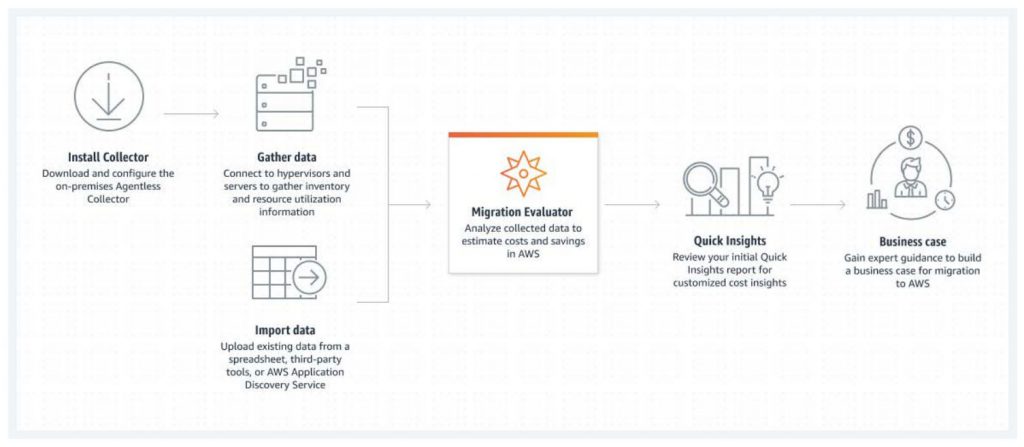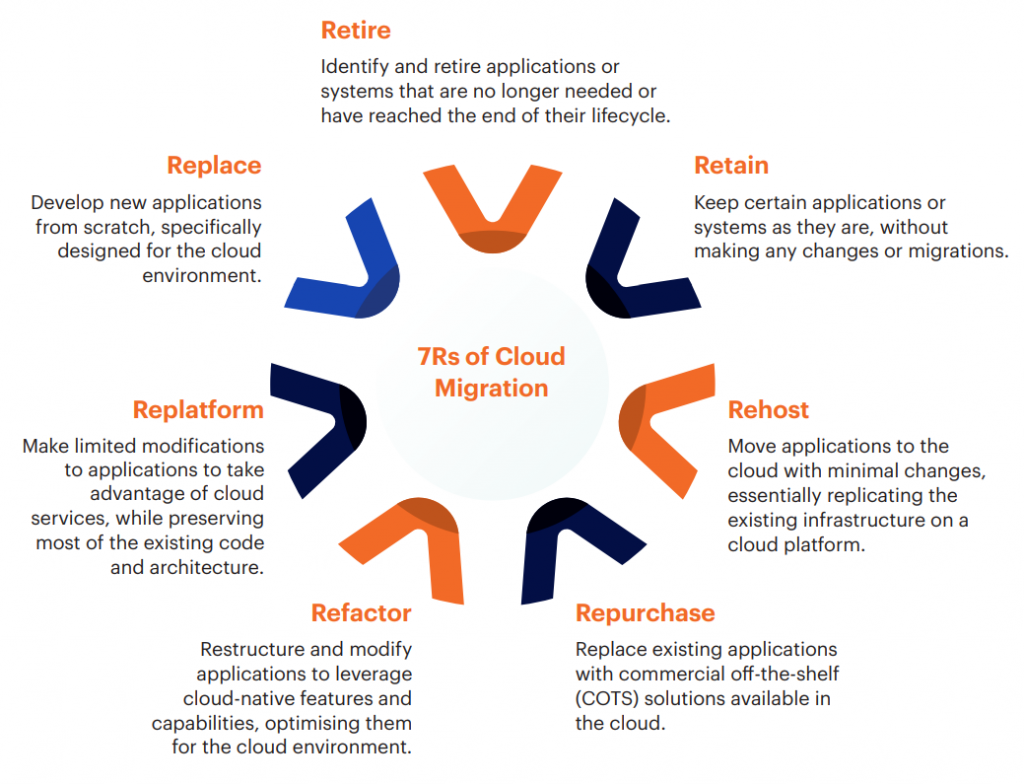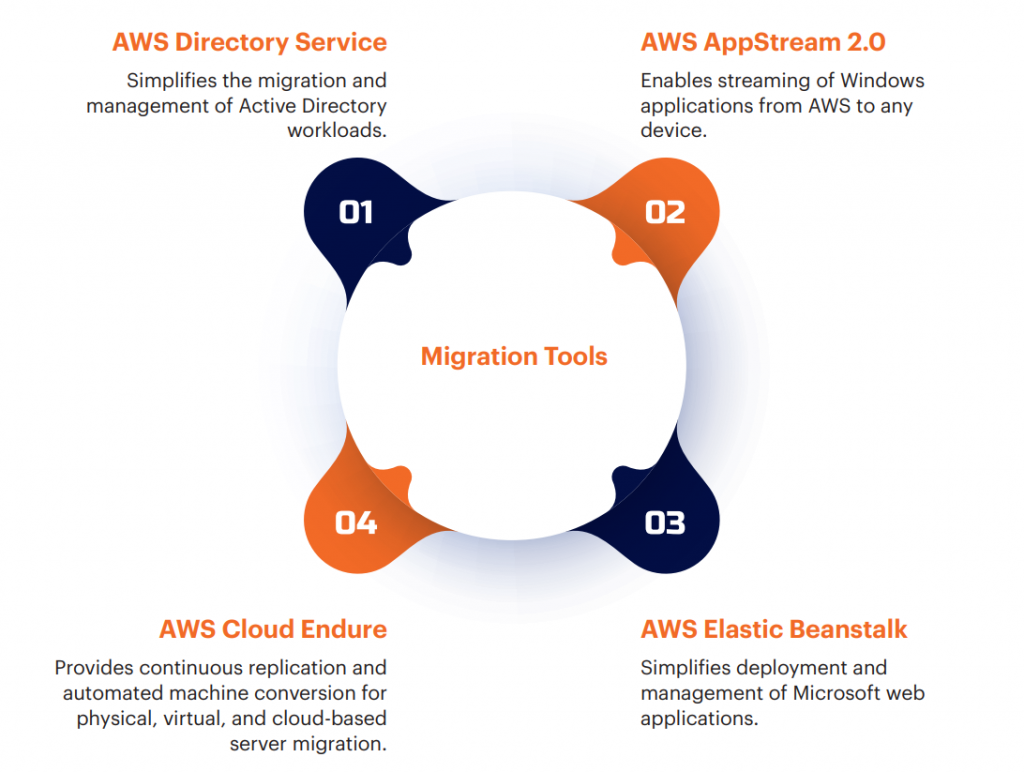Migrate Microsoft Workload to AWS
A Detailed Guide from Motherson Technology Services
In today’s day and age, businesses use a huge amount of data for their day-to-day operations. With the evolving technology landscape, enterprises need to scale their infrastructure often and cost-effectively. It can be challenging to do so with running company-wide applications like Windows on-premises. Migrating Microsoft workloads to the cloud offers flexibility, scalability, and cost efficiency. Today’s IT leaders are increasingly adopting the cloud to scale their IT infrastructure.
According to Gartner, the rapid pace of innovation in the cloud is expected to drive global public cloud end-user spending by over $600 billion by 2023. Using cloud computing offers a significant advantage to IT leaders and practitioners, and with cloud, organisations are 14% more likely to surpass organisational performance targets compared with their counterparts who do not embrace the cloud.
This whitepaper introduces AWS migration tools, explores the 7Rs of cloud migration, and covers critical migration strategies. By understanding these tools and migration strategies, organisations can plan and execute successful migrations to AWS, unlocking the benefits of a scalable and secure cloud platform.
Price, Performance and Productivity
Migrating workloads to the cloud offers a range of economic benefits that extend beyond cost savings. While cost reduction is a significant advantage, organisations also experience increased staff productivity, improved application performance and availability and enhanced business agility.

Improved Application Performance and Availability
AWS offers a scalable infrastructure for high-performance and available applications. Leveraging the cloud's elasticity, businesses can scale resources based on demand, eliminating overprovisioning. This flexibility optimises costs by paying for actual resource usage and maintains optimal application performance during peak periods.

Enhanced Business Agility
Cloud computing allows businesses to respond quickly to market changes and requirements. With on-demand resources, organisations can rapidly deploy and scale applications, fostering faster innovation and time to market. This agility empowers businesses to seize opportunities, launch products/services quickly and adapt to evolving customer needs, driving business growth and competitive advantage.

Cost Savings Beyond Infrastructure
The economic benefits of cloud migration go beyond infrastructure. Organisations can save on hardware and software maintenance, energy consumption, data centre space and licensing. The pay-as-you-go pricing model of the cloud aligns costs with usage, eliminating upfront investments and providing better cost predictability.
Assessing the Current State and Creating a Roadmap
Cloud migration can benefit organisations with an efficient IT infrastructure. However, before starting the cloud migration process, it is crucial to do a cloud assessment. Cloud assessment enables informed decisions, cost optimisation, risk mitigation, performance enhancement, strategic planning, and business continuity during the migration process. Here is how cloud migration helps businesses:
There are a range of cloud assessment tools to prioritise and streamline the migration process.
![]() Migration Evaluator
Migration Evaluator
It enables data-driven decision-making for AWS migration, helping define migration steps and achieve business objectives. It provides access to AWS expertise, cost-effective migration scenarios, and insights on software licensing reuse for cost reduction. The tool helps build an AWS roadmap by fine-tuning licensing, assessing server dependencies, and exploring migration scenarios. It also assists in estimating and reducing cloud costs, analysing the current state, defining the target state, and developing a migration readiness plan aligned with financial objectives.

![]() Migration Portfolio Assessment
Migration Portfolio Assessment
It automates portfolio analysis, validates business cases, and enables efficient data management. The tool prioritises applications based on migration drivers, compares AWS and on-premises costs, and creates application groups based on dependencies. It estimates migration project costs, generates migration wave plans, recommends migration strategies, and provides customisable visualisation of portfolio data. Migration Portfolio Analysis supports collaboration, sharing, and downloading reports for analysis and presentation purposes. Use cases include portfolio analysis, data consolidation, and collaboration.
![]() Migration Readiness Assessment
Migration Readiness Assessment
It is a comprehensive evaluation of an organisation’s readiness for cloud migration. With Migration Readiness assessment factors such as infrastructure readiness, security requirements, data governance, and compliance are assessed. This assessment helps to develop a mitigation plan and ensure a smooth migration process.
![]() AWS Storage Discovery Assessment
AWS Storage Discovery Assessment
It focuses on analysing the data storage requirements. It helps us understand the volume and types of data that need to be migrated, assesses data transfer costs, and identifies opportunities for data storage optimisation in the cloud.
![]() AWS Optimisation and Licensing Agreement (OLA)
AWS Optimisation and Licensing Agreement (OLA)
AWS OLA streamlines licence and compute cost optimisation for cloud migration. It helps assess on-premises and cloud environments, enhancing resource efficiency and reducing required instances. Further, AWS OLA uncovers potential cost savings through flexible licensing options.

The Big Picture
When planning a migration to AWS, organisations need to define a migration strategy that aligns with their business objectives, technical requirements, and timeline. AWS offers a range of migration strategies. This section will explore some common migration strategies.
![]() AWS Application Migration Service (AMS)
AWS Application Migration Service (AMS)
The Application Migration Service simplifies, expedites, and reduces the cost of migrating and modernising applications. It accelerates and automates migration and modernisation, making the process easier. By automating the conversion of your source servers to run natively on AWS, it minimises time-intensive, error-prone manual processes. Additionally, the service offers built-in and custom optimisation options, simplifying application modernisation.
![]() AWS Database Migration Service (DMS)
AWS Database Migration Service (DMS)
For databases, AWS DMS is a powerful tool that enables organisations to migrate their on-premises databases to AWS with minimal downtime. DMS supports various source and target database engines, including popular options like Oracle, Microsoft SQL Server, MySQL and PostgreSQL. It facilitates both homogeneous and heterogeneous database migrations, allowing organisations to take advantage of managed database services like Amazon RDS or Amazon Aurora.
![]() AWS DataSync
AWS DataSync
AWS DataSync simplifies and accelerates the migration of large amounts of data from on-premises storage systems to AWS. It securely transfers data over the network, optimising the process to minimise migration time. Data Sync supports various storage systems, including Network Attached Storage (NAS), self-managed object storage and third-party storage providers. It enables efficient data transfer to AWS services like Amazon S3, Amazon EFS and Amazon FSx.
![]() AWS Migration Hub | The Command Center
AWS Migration Hub | The Command Center
AWS Migration Hub simplifies the management and tracking of your migration to the AWS cloud. It offers real-time visibility, centralised tracking, and resource utilisation monitoring. With AWS Migration Hub, you can easily monitor the progress of your migration projects through a unified dashboard. It integrates with various migration tools, eliminating the need to access multiple platforms.
![]() 7Rs of Cloud Migration | The Thumb Rule
7Rs of Cloud Migration | The Thumb Rule
Cloud migration has become a vital strategic requirement during the pandemic, and businesses will continue to invest strategically in hybrid and multi-cloud solutions.
Organisations using hybrid and multi-cloud environments have witnessed significant revenue growth. In a recent survey, 83% of IT leaders reported increased revenue compared to enterprises with non-hybrid and non-multi-cloud users. Flexibility and choice are key factors for businesses seeking the right mix of clouds and companying tools to meet their unique needs.
To ensure flexibility, the 7Rs of migration provide a framework for categorising the treatment of systems and applications during the migration process. These 7R’s represent different approaches to handling applications and data, each with its level of complexity and effort. The 7Rs are listed below:

Migrating legacy Microsoft Windows workloads to open-source and cloud-first alternatives on AWS can help enterprises cut or eliminate expensive licensing costs. By modernising their applications, businesses can achieve significant savings and optimise their licensing expenses. Some of the tools that can help with this migration include:

AI/ML, DevOps, Security
When migrating operations to the cloud, DevOps practices and advanced tech like ML and AI are vital. DevOps fosters collaboration and automation, while ML and
AI provide insights, automation, and improved performance.
DevOps-driven cloud migration blends best practices with CI/CD, automation, and monitoring. ML and AI offer benefits like task automation, issue identification, scalability, cost savings, and enhanced security.
ML and AI capabilities offer significant benefits in optimising IT infrastructure during migration. They automate processes, analyse data, make predictions, and improve overall efficiency. Combining these technologies with DevOps practices, we can achieve successful and efficient cloud migration.
A recent IDC survey suggests AI-driven cloud migration will become the norm for digital transformation, accompanied by therise of low-code and no-code strategies. By 2026, AI-driven features will be integrated into various business technology categories, with 60% of organisations leveraging them to achieve better results without relying on specialised AI expertise. Considering this data and evidence, cloud migration will be a paradigm shift for enterprise solutions in the coming years, with the Asia-Pacific region poised for rapid growth alongside the West.
With You Always
Cloud migration is a complex process, but Motherson’s expert team can help you with it. With years of experience and deep expertise in guiding businesses through successful cloud migrations, Motherson specialises in making your transition to the cloud smooth and efficient. From rightsizing your infrastructure to optimising resource utilisation, enhancing security, and achieving cost savings, we prioritise every aspect of your migration to deliver exceptional results. Our track record of satisfied customers speaks volumes about our capabilities. You can trust Motherson Technology Services to prioritise security, resilience, high availability, and efficiency through our well-architected reviews.
![]() Years of Experience and Expertise
Years of Experience and Expertise
With extensive experience in cloud migrations, Motherson’s expert team delivers tailored solutions that align with your unique requirements. Our in-depth knowledge of the cloud ecosystem enables us to navigate complexities and help organisations leverage the full potential of cloud technologies.
![]() Smooth and Efficient Cloud Migrations
Smooth and Efficient Cloud Migrations
At Motherson, we meticulously plan each migration project, carefully assessing your infrastructure and applications. Our migration strategy ensures a seamless transition to the cloud, with a focus on rightsizing your infrastructure for efficiency and cost savings.
![]() Security and Resilience
Security and Resilience
Motherson prioritises security throughout the migration process, implementing robust measures to safeguard your data and applications. Thorough well-architected reviews ensure a resilient, highly available and protected cloud environment.
![]() Cost Savings and Resource Optimisation
Cost Savings and Resource Optimisation
Recognising the importance of cost savings, Motherson’s skilled team identifies opportunities to optimise costs during a migration. We streamline your infrastructure, maximising resource utilisation and eliminating unnecessary expenses to bring tangible benefits to your business.
Wrapping Up
Today’s enterprises are driven by data and are fuelled by digitisation. In this scenario, Gartner’s projections about growth in end-user spending on Infrastructure as a Service (IaaS) at a rate of 30.6% year-over-year do not come as a surprise. Cloud plays a central role in the IT strategy of companies transforming their legacy systems to keep up with the evolving business landscape. And cloud migration is integral and central to the success of the IT strategy.
Embracing the cloud is essential for success, and at Motherson Technologies, we’re here to guide your organisation through a seamless and efficient cloud migration. With years of experience and expertise, our tailored solutions align with your unique needs, unleashing the full potential of cloud technologies. Our team of experts ensures a smooth migration strategy, optimising resources while prioritising security and resilience.
As cloud infrastructure demands grow, we recognise the importance of multi-cloud solutions. Microsoft’s research confirms this trend, with 71% of customers seeking investment flexibility and best-of-breed cloud capabilities.
Let us be your trusted partner on this transformative journey.